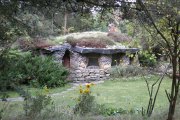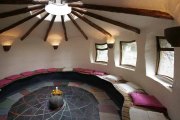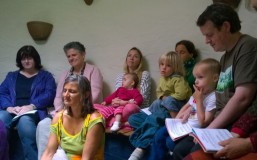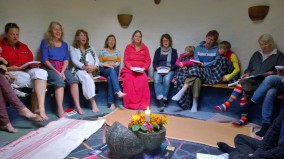This post is about my most valued spiritual practice – the one that is most effective and the one I most enjoy. Every weekday morning, I step out of the house at 8 am, walk across the road, along a narrow stone pathway that winds its way through vegetation, up and over a wee mound, and delivers me to the entrance of one of the best loved and most photographed buildings in our community, the Nature Sanctuary, famous around the world for it’s organic form and materials, as well as the beauty and symbolic power of its interior. This magical and sacred space that is home to one of our most well established community rituals. We call it Taizé.
 |
 |
 |
Taizé is actually a monastery and community in France – “a community where kindness of heart and simplicity [are] at the centre of everything”. (Quote from Brother Roger who established the monastery shortly after WWII.) Run by catholic brothers, it attracts thousands of local and international visitors every year – people from many different backgrounds and faiths. They come in good part because of the style of worship, which is based on the singing of short, simple, songs, repeated time and time again much like a mantra might be in meditation. Indeed, the singing of these songs is a meditation. This quote from their website, http://www.taize.fr/, sums it up.
“Using just a few words they express a basic reality of faith, quickly grasped by the mind [and] sung over many times, this reality gradually penetrates the whole being. Meditative singing becomes a way of listening to God. It allows everyone to take part in a time of prayer together and to remain together in attentive waiting on God.”
I find myself smiling at my choice of this quote. As I wrote in an earlier post, I have been areligious all my life. I had an orthodox Jewish upbringing but had decided by the time I was 12 or so that the notion promulgated at Sunday School, of a single, omnipotent, omniscient God the creator, was an invented nonsense. I have been an atheist in respect of such a God ever since. But in being at Findhorn, I have slowly released my resistance to the use of the ‘G word’. Indeed I use it myself these days in reference to an entirely different kind of God – the god within – that spark of divinity that exists within us all. This conceptualisation fits with my humanistic worldview. It’s shorthand, as I see it, for that potential we all have as human beings for the fullest possible expression of creativity, service and love, amongst other things. (See my second post, A Spiritual Life, for the full rave.)
Before getting back to the topic, I’d like to do a little more context setting. Our community here at Findhorn is very rich in many different ways. Daily life is packed with interest. In part, I’m motivated to write this blog because I know there will be lots of ‘raw material’ to draw on in the coming weeks and months. A strong aspect of that richness is our cultural life. At Findhorn, there is singing, dancing and performance of all kinds. We sing and dance spontaneously e.g the kitchen crew, which currently includes several Latins from Spain and South America, frequently dance their way through a work shift. And we sing, dance and perform more formally, for example: in Sacred Dance sessions scheduled once or twice a week; in fortnightly Open Mike sessions (impromptu performances by musicians and poets); in monthly ‘Sharings’ (of recitals, comedy, performances etc.); and in Taizé. Our cultural life is a key ingredient of the community glue here, along with our spirituality and ecological concerns and practices. These three strains to the culture are separate and distinct, but also blend together beautifully to help build the culture and strengthen relationships. I suspect that much of what I write about in the coming months will be these kinds of activities and events. But, back to Taizé… or rather off to Taizé. I’ve just noticed it’s now 7:50 and time to go singing. I’ll pick this up upon my return in half an hour.
Taizé landed in Findhorn in the mid 1980s with the arrival of Barbara Swetina, a much loved community songstress and musician who has lived here ever since. She had just come from the Taizé monastery and was inspired. Another long-standing and deeply appreciated community member, Ian Turnbull had just finished building the Nature Sanctuary. Ian’s sacred space seemed like a perfect match for Barbara’s prayerful singing, so together, they initiated half-hour long, morning Taizé sessions that have continued in the same space until today. The sessions are facilitated by one of a dedicated group of leaders who set up the space, select the songs and lead the singing. Somewhere between ten and thirty people attend, depending on the season and the number of guests we have visiting at the time. (The two are correlated; many more guests come in summer than at other times.) Most songs are sung in three or four part harmony. So we sit grouped in our voice parts: base, tenor, alto and soprano.
We begin by sounding three OMs. This is a way of bringing ourselves present, warming up our voices and somehow preparing the ground for spirit to enter – for the participants to align with their essence, source, higher self or inner divinity (pick your own understanding). There are usually just four songs, each or which lasts about five minutes. Actually, the song itself is only a few lines long but is repeated ten or twenty times. The first song is usually a round, without voice parts but still sprightly, requiring quite some focus and concentration. This will be followed by two more songs in harmonised voice parts. These are usually slower in pace and more meditative. They are melodic, generally quite beautiful, and simple (easy to learn). The lyrics are usually in Latin since they are mostly Christian in origin. But there are plenty of other songs from different religions and spiritual traditions.
After the third song, we spend a few minutes in prayer. As the leader will inevitably announce (for the benefit of newcomers), “prayers can be spoken out loud in any language or in the silence of our hearts”. I find this a particularly precious time of sharing what’s important to us, and of being reminded of the universality of being human i.e. no matter what our background, belief system, age or education…we share a commonality of: needs and wants; fears and concerns; dreams and aspirations. We usually have guests from all around the world, and mostly their prayers resonate with all of us … with the collective unconscious. Finally, we finish with an upbeat song that sends us out into the world with a smile … and in my case with an earworm. I usually sing aloud the same song as I walk to the Main Sanctuary which is the venue for the next phase of my morning practice. And the subject of anther post.
I want to finish this post on a personal note, somewhat prompted by this quote that I found on the Taizé monastery website… “To open the gates of trust in God, nothing can replace the beauty of human voices united in song. This beauty can give us a glimpse of “heaven’s joy on earth,” as Eastern Christians put it. And an inner life begins to blossom within us.” Those of you who have read my earlier posts will know of the unfolding of my spiritual journey at Findhorn and how I arrived here 9 years ago with little space in my worldview for such concepts as God, spirit, subtle realms, and the myriad more esoteric aspects of Findhorn’s history and culture. And that now, in the last few years at least, my attitudes have softened and changed. I am now much more open-hearted and open-minded. Well, I would say that Taizé has been one of the primary influences; its essence, it’s core message i.e. “to open the gates of trust in God,” has slowly seeped into my being. I now trust where once I would have been sceptical and suspicious.
The other way in which Taizé has been hugely personally transformative, and for which I will be eternally grateful, is this; I arrived in Findhorn convinced that I was not, and would never be, a singer. I had spent a lifetime being certain that I was tone deaf. So, even attending Taizé in the early days was challenging, but I have always loved listening to music, particularly choral singing. So I initially attended for the opportunity to listen in, and indeed, be immersed in some live, good quality, choral singing. It didn’t take long for the music to weave its magic. Due simply to the nature of the songs – that they are short, simple, tuneful, repetitive and easy to remember – I started to sing along, very quietly at first.
It took me a while and quite some practice before I gained confidence, but sure enough the confidence came. And, in what I perceived to be, the non-judgemental atmosphere of the sessions, I started to sing louder and with more feeling. Soon I started to believe that perhaps I was able to sing in tune after all. And when I asked the experienced singers on either side of me, they assured me that indeed, I was singing in tune and furthermore, I had quite a strong and rich singing voice. I have never looked back. These days I sing without self-consciousness. And in doing so, I completely lose myself in the music. It has become for me, a real meditation – a means by which I access inner stillness, peace of mind and openness of heart…every day. Such is the potential for personal growth and transformation in the practices we have evolved here in Findhorn .
 |
 |
PS: As you can see above, we often have children attend Taizé, usually whilst we are running a Family Experience Week or some other family oriented programme. When this happens, we often vary the playlist to include at least one song that is more fun and accessible for the kids. I recorded a short video of a recent such occasion….

Richard Valeriano would love this!
LikeLike
Graham, I’ve been gratefully following your blog since you began it and have appreciated your posts very much, especially since I so thoroughly enjoyed meeting you, first, a couple of years ago at the particular Eco-Village Experience Week that I and my three other colleagues from Milwaukee and Marquette University were part of in April of 2012, and then, again, at the conference you directed last summer. I felt an affinity for you and how you carried yourself, what you talked about, what you valued, right away. So, reading your blog is especially meaningful to me. This particular entry is VERY meaningful to me as I spent Holy Week of 1977 at Taize, with just a knapsack and a blanket in a tent during that week that six inches of snow fell. This was my first Easter week of my six years of study in Rome, and it still remains the most meaningful. I have experienced “Taize” as you say, in several setting around the world: The San Egidio community in Trastevere, Rome, at the Camaldolese Monastery in the Big Sur in California, at Mother Theresa’s Brother community in Calcutta, India, and even at one of the Coptic Churches in Jordan. It is indeed a great elixer for the soul. Marquette University (who is still in mourning for the tragic loss (the beheading) of one of our grads, the fine Journalist, James Foley) has a “Taize evening” in the Chapel of the Holy Family on Campus every Thursday evening. Cheers and Blessings. Bob Deahl
LikeLike
Hi Bob
Gee thanks very much for your long and generous comment. It’s great to hear of your involvement with Taize over the years and in a range of places. I really didn’t have much of an idea about how widespread and popular it is around the world. Very sorry to hear that Foley was one of your alumni. For me it would really stretch faith and credulity to have been so close to such a horrific event…. as does the whole war-mongering hegemony, economy and industry.
Anyway, great to hear from you. My daughter and family are in Chicago at the moment. I’d suggest they hook up with you except that I know they don’t have long there are will be ensconced with family.
Much love to you Bob. I hope we see you back here again one day.
Graham
LikeLike
Thanks much Graham, and many blessings!
LikeLike